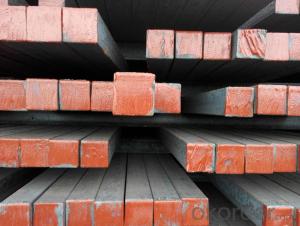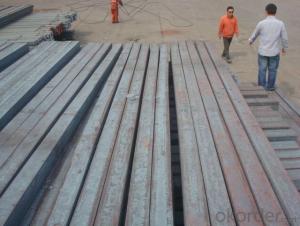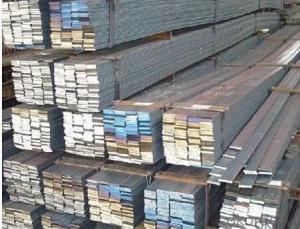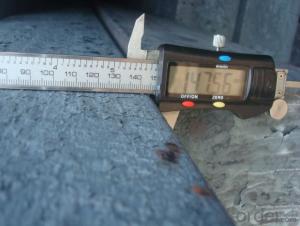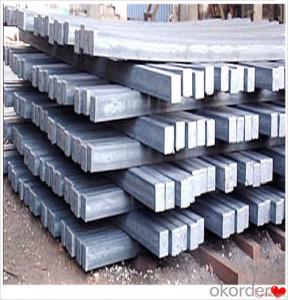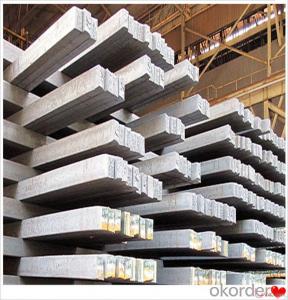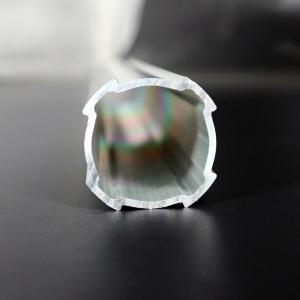Steel Square Billets for construction Q195 and Q235 Materials
- Loading Port:
- China main port
- Payment Terms:
- TT OR LC
- Min Order Qty:
- 50 m.t.
- Supply Capability:
- 100000 m.t./month
OKorder Service Pledge
OKorder Financial Service
You Might Also Like
Product Description of Steel Square Billets for construction Q195 and Q235 Materials
| GRADE | SIZE | APPLICATION |
Q195/ 215 | 100mm*100mm*6m | REBAR |
| 120mm*120mm*6m | ||
| 130mm*130mm*6m/12m | ||
| 150mm*150mm*6m/12m |
Chemical Compositon of Steel Square Billets for construction Q195 and Q235 Materials
Q195/ 215 | C (%) | Si (%) | Mn (%) | P(%) | S(%) |
| 0.06-0.12 | 0.15-0.30 | 0.35-0.50 | 0.045% Max | 0.045Max |
Technology process of Steel Square Billets for construction Q195 and Q235 Materials
1.Heat the EVA film
2.Cover the heated EVA film on the mould(can be made from wood or aluminum)
3.Spray a coating in a certain baume degree
4.Put on the empty blask
5.Sand-up the flask and vibrate to compaction
Packaging & Delivery of Steel Square Billets for construction Q195 and Q235 Materials
Packaging Details:containers
Delivery Detail:Complete one set of equipment needs for three months
The products can be delivered by bulk vessel or by container. As for container, products with the length of 6m will be loaded in 20’ container, with 9m or 12m, in 40’ container.
-The maximum quantity of loading of container is 25 tons.
-The products usually are transported to the nearest port from the production place.
Products Show

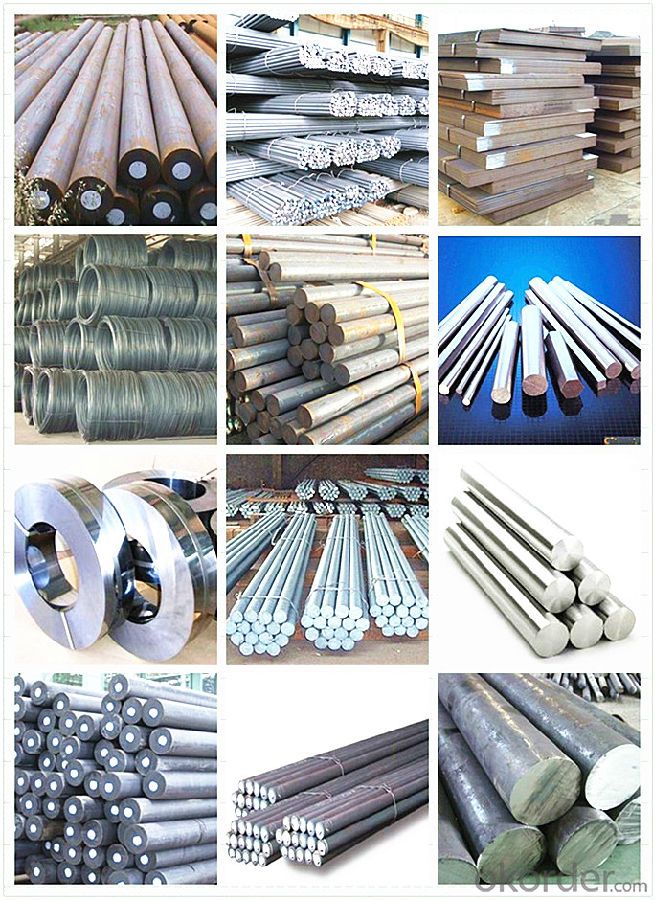
FAQ:
1.Your advantages?
Professional products inquiry, products knowledge train (for agents), smooth goods delivery, excellent
customer solution proposale
2. Test & Certificate?
SGS test is available, customer inspection before shipping is welcome, third party inspection is no problem
3. Factory or Trading Company?
CNBM is a trading company but we have so many protocol factories and CNBM works as a trading department
of these factories. Also CNBM is the holding company of many factories.
4. Payment Terms?
30% TT as deposit and 70% before delivery.
Irrevocable L/C at sight.
5. Trading Terms?
EXW, FOB, CIF, FFR, CNF
6. After-sale Service?
CNBM provides the services and support you need for every step of our cooperation. We're the business
partner you can trust.
For any problem, please kindly contact us at any your convenient time.
We'll reply you in our first priority within 24 hours.
- Q:What are the advantages of using steel billets over other materials?
- Using steel billets instead of other materials has several advantages. To begin with, steel billets possess remarkable strength and durability. Steel is renowned for its high tensile strength, making it perfect for applications that require bearing heavy loads. This property enables steel billets to withstand substantial weights and resist deformation, ensuring the integrity and longevity of structures. Additionally, steel billets offer exceptional machinability and formability. Steel is an adaptable material that can be easily shaped and molded into various forms, allowing for customization and flexibility in design. This makes it suitable for a wide range of applications in industries such as construction, automotive, and manufacturing. Moreover, steel billets exhibit superior resistance to heat and corrosion. Steel inherently resists heat and can endure high temperatures without compromising its structural properties. This makes it suitable for applications that involve exposure to extreme temperatures, such as in the aerospace and energy sectors. Furthermore, steel possesses excellent corrosion resistance, guaranteeing its longevity and minimizing maintenance costs. Another advantage of steel billets is their recyclability. Steel is one of the most recycled materials globally, boasting a high recycling rate. This not only reduces the environmental impact of steel production but also makes it a more sustainable choice. Moreover, the recycling process does not compromise the quality or performance of steel, allowing for continuous reuse. Lastly, steel billets offer cost-effectiveness. Despite their numerous advantages, steel billets remain a cost-effective material in comparison to other alternatives. Their widespread availability, ease of manufacturing, and recyclability contribute to their affordability. Furthermore, the durability and low maintenance requirements of steel billets result in long-term cost savings for users. In conclusion, the utilization of steel billets presents various advantages in terms of exceptional strength, machinability, heat and corrosion resistance, recyclability, and cost-effectiveness. These qualities establish steel billets as the preferred choice in various industries, ensuring reliable and long-lasting performance.
- Q:How are steel billets used in the manufacturing of wire rods?
- Steel billets are used in the manufacturing of wire rods as they are heated and then rolled into thin, long cylindrical shapes. These billets undergo a series of processes such as hot rolling, cooling, and wire drawing to transform them into wire rods of various sizes. The wire rods are then utilized in various industries for applications like construction, automotive parts, and electrical wiring.
- Q:What is the role of steel billets in the manufacturing of construction machinery?
- Steel billets play a crucial role in the manufacturing of construction machinery due to their exceptional strength and durability. These billets, which are semi-finished products made from molten steel, are shaped into various forms such as bars, rods, or sheets, depending on the specific machinery being produced. One of the primary reasons steel billets are used in the construction machinery industry is their ability to withstand heavy loads and extreme conditions. Construction machinery, such as excavators, bulldozers, cranes, and loaders, are subjected to intense stress and pressure during operation. Steel billets, being made from high-quality steel, provide the necessary structural integrity and resistance to deformation, ensuring the machinery can handle demanding tasks without compromising safety or performance. Additionally, steel billets offer excellent weldability, which is crucial in the construction machinery manufacturing process. Welding is often required to join different components together, and the use of steel billets ensures strong and reliable welds, contributing to the overall stability and longevity of the machinery. Moreover, steel billets can be easily machined and formed into complex shapes, allowing for the production of intricate parts and components required for construction machinery. This versatility enables manufacturers to design and fabricate machinery with precise specifications, enhancing their functionality and efficiency on the job site. Furthermore, steel billets are known for their resistance to corrosion and rust, making them ideal for construction machinery that is frequently exposed to harsh environmental conditions, including moisture, chemicals, and abrasive materials. This resistance ensures the longevity of the machinery, reducing maintenance costs and downtime. In summary, steel billets are indispensable in the manufacturing of construction machinery due to their strength, weldability, machinability, and resistance to corrosion. By incorporating steel billets into the production process, manufacturers can create robust and reliable machinery that can withstand heavy loads, extreme conditions, and perform efficiently in the construction industry.
- Q:Are steel billets used in the manufacturing of oil and gas pipelines?
- Yes, steel billets are commonly used in the manufacturing of oil and gas pipelines. Steel billets are semi-finished products that are typically produced through a process called continuous casting, where molten steel is solidified into a rectangular shape. These billets serve as the starting material for various steel products, including pipes used in the oil and gas industry. The manufacturing process of oil and gas pipelines involves several steps, one of which is the production of seamless or welded steel pipes. Steel billets are heated and then rolled into tubes or pipes through a process called pipe making. For seamless pipes, the heated billet is pierced to form a hollow shell, which is then elongated and shaped into a pipe. Welded pipes are created by rolling and welding a flat plate of steel to form a tube. The use of steel billets in pipeline manufacturing is preferred due to the excellent mechanical properties of steel, including its strength, durability, and resistance to corrosion. These properties make steel an ideal material for pipelines that need to withstand high-pressure environments and harsh conditions. Additionally, steel billets can be customized in terms of size, shape, and composition to meet the specific requirements of each pipeline project. In conclusion, steel billets play a crucial role in the manufacturing of oil and gas pipelines. They serve as the raw material that is transformed into seamless or welded pipes, which are then used to transport oil and gas across long distances. The use of steel ensures the reliability and integrity of these pipelines, making them essential components of the oil and gas industry.
- Q:Are steel billets used in the production of household appliances?
- Yes, steel billets are used in the production of household appliances. Steel billets are semi-finished steel products that are used as raw material in various industries, including the manufacturing of household appliances. These billets are heated and then rolled or forged into different shapes and sizes to create components such as sheets, plates, rods, and bars that are used in the production of appliances. Steel is a preferred choice for household appliances due to its strength, durability, and resistance to corrosion. It is commonly used in the production of refrigerators, washing machines, dishwashers, ovens, and many other household appliances.
- Q:Can steel billets be customized in terms of shape and size?
- Yes, steel billets can be customized in terms of shape and size. Steel billets are semi-finished products that are typically rectangular in shape and are used as raw material for various manufacturing processes. However, they can be altered to meet specific requirements by undergoing a process known as billet rolling or cross-rolling. During this process, the steel billets are passed through a series of specially designed rolls that apply pressure and force to reshape them. This allows for the customization of the billets into different shapes and sizes, such as square, round, or hexagonal, based on the desired end product. Additionally, the size of the steel billets can also be customized. The initial dimensions of the billets can be adjusted by either increasing or decreasing their length, width, and height. This flexibility in customization enables manufacturers to produce steel billets that best suit their specific production needs. In conclusion, steel billets can indeed be customized in terms of both shape and size through the process of billet rolling. This allows manufacturers to adapt the billets to their desired specifications, enabling them to create a wide range of products using steel as a raw material.
- Q:Can steel billets be forged into complex shapes?
- Complex shapes can be achieved by forging steel billets. The process involves heating the billet to a specific temperature, usually above its recrystallization temperature, and then applying pressure to shape it. Various forging techniques like open die, closed die, or impression die forging can be used. Steel is highly malleable and can be easily shaped and deformed under heat and pressure. This property allows steel billets to be forged into intricate shapes like gears, turbine blades, automotive parts, and other components used in different industries. Forging not only shapes the billet but also enhances its mechanical properties, making it stronger and more durable. The resulting forged steel has a refined grain structure, improving its toughness, resistance to fatigue, and resistance to cracking. However, forging complex shapes from steel billets requires skilled craftsmanship and specialized equipment. The process may involve multiple steps like pre-forming, rough forging, and finish forging to achieve the desired shape and dimensions. Computer-aided design (CAD) and computer-aided manufacturing (CAM) technologies are often used to optimize the forging process and ensure precision and accuracy. To sum up, steel billets can be forged into intricate shapes. Through forging, the malleability of steel is harnessed to create components with improved mechanical properties.
- Q:What is the role of steel billets in the construction of dams and reservoirs?
- Steel billets play a crucial role in the construction of dams and reservoirs. These billets, which are semi-finished steel products, serve as the primary raw material for manufacturing various components and structures needed in the construction process. One of the main applications of steel billets in dam and reservoir construction is for the production of reinforced concrete. Reinforced concrete is a composite material that combines the strength and durability of steel with the moldability and versatility of concrete. Steel billets are used to produce steel reinforcement bars, commonly known as rebars, which are embedded within the concrete to enhance its tensile strength and prevent cracking under heavy loads. These rebars provide structural support to the dam or reservoir, ensuring its stability and longevity. Additionally, steel billets are utilized in the fabrication of gates, penstocks, and other mechanical components required in dams and reservoirs. These components are crucial for regulating the flow of water, controlling the water level, and managing the release of water from the reservoir. Steel billets are forged, rolled, or machined to create these specialized components, ensuring their strength, reliability, and resistance to corrosion. Furthermore, steel billets are used in the construction of spillways, which are designed to safely discharge excess water from reservoirs during periods of heavy rainfall or flood. The spillway gates, channels, and other structures are often made from steel billets, as they need to withstand high water pressure and turbulent flow conditions. In summary, steel billets are indispensable in the construction of dams and reservoirs. They are used to produce reinforced concrete, providing structural support and increasing the overall strength of the structure. Steel billets are also employed in the manufacturing of gates, penstocks, spillways, and other mechanical components, guaranteeing the efficient operation and long-term durability of these essential water management infrastructure.
- Q:What are the potential applications of steel billets in the defense sector?
- Steel billets have a range of potential applications in the defense sector, including the manufacturing of armored vehicles, tanks, and naval vessels. They can also be used for constructing military infrastructure, such as bunkers, fortifications, and barriers. Additionally, steel billets can be utilized in the production of various weapons and ammunition, such as artillery shells and components for firearms. The strength, durability, and versatility of steel make it an essential material for various defense applications.
- Q:How are steel billets used in the production of railway wheels?
- Steel billets are an indispensable element for manufacturing railway wheels. These billets, which are essentially semi-finished forms of steel, serve as the initial stage of the production process. To begin the production of railway wheels, the steel billets are subjected to high temperatures in a furnace. This heating process, known as hot rolling, enhances the steel's malleability and ductility, making it easier to shape. Once the billets have reached the desired temperature, they undergo a series of rolling operations. These operations gradually shape the billets into the required size and form for railway wheels. High pressure is applied to the billets during this rolling process, causing them to elongate and take on the desired shape. After the rolling process, the shaped billets undergo further processing to eliminate any excess material and refine the surface finish. This step ensures that the final product meets all the necessary specifications for railway wheels. Lastly, the shaped billets are sent for additional machining, where they are turned, drilled, and finished to create the final railway wheel. This machining process is essential in achieving the required dimensions, balance, and surface quality needed for safe and efficient operation. In conclusion, steel billets play a vital role in the production of railway wheels. They are heated, rolled, shaped, and further processed to create the essential components for the final product. Without steel billets, the production of railway wheels would not be feasible.
1. Manufacturer Overview |
|
|---|---|
| Location | |
| Year Established | |
| Annual Output Value | |
| Main Markets | |
| Company Certifications | |
2. Manufacturer Certificates |
|
|---|---|
| a) Certification Name | |
| Range | |
| Reference | |
| Validity Period | |
3. Manufacturer Capability |
|
|---|---|
| a)Trade Capacity | |
| Nearest Port | |
| Export Percentage | |
| No.of Employees in Trade Department | |
| Language Spoken: | |
| b)Factory Information | |
| Factory Size: | |
| No. of Production Lines | |
| Contract Manufacturing | |
| Product Price Range | |
Send your message to us
Steel Square Billets for construction Q195 and Q235 Materials
- Loading Port:
- China main port
- Payment Terms:
- TT OR LC
- Min Order Qty:
- 50 m.t.
- Supply Capability:
- 100000 m.t./month
OKorder Service Pledge
OKorder Financial Service
Similar products
New products
Hot products
Hot Searches
Related keywords
